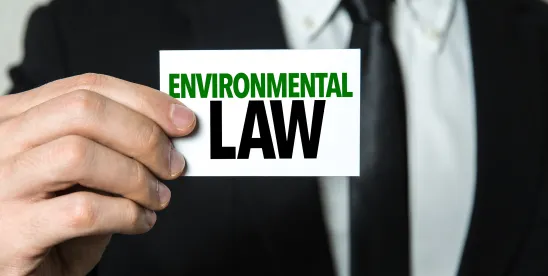On Friday, 28 June 2024, the US Supreme Court released its opinion in Loper Bright Enterprises v. Raimondo and Relentless, Inc. v. Department of Commerce (collectively Loper Bright), overturning Chevron v. Natural Resources Defense Council. Loper Bright’s impact will be profound and immediate on how federal agencies, including the Environmental Protection Agency (EPA), implement our nation’s environmental laws and regulations. The decision presents significant opportunities to regulated entities who may now challenge a wide range of existing environmental regulations and agency interpretations, with far greater means to shape environmental regulations going forward. Though the Court emphasized that past decisions under Chevron remain good law subject to stare decisis, the landmark ruling opens the door for further challenges to agency actions, including recent rulemakings by EPA. Without Chevron as a backstop, EPA rules are now more susceptible to legal challenges for vagueness or failing to have sufficient delegated authority. Additionally, Congress is certainly going to have to consider providing more explicit delegations of authority in legislative initiatives going forward, and regulated entities should be immediately reviewing their legal options.
For a comprehensive explanation of the Loper Bright decision and Chevron, see our recent alert.
POTENTIAL IMPACTS ON EPA REGULATIONS
There are a wide range of environmental programs and issues that may be impacted by the Loper Bright ruling, several examples of which include:
Climate Change
EPA recently issued a series of regulations addressing climate change, which the Biden administration adopted quickly to avoid scrutiny under the Congressional Review Act (CRA). These rules include greenhouse gas emissions standards for fossil fuel-fired power plants, detailed in our recent alert, which were reissued following the Supreme Court’s use of the “major questions doctrine” to invalidate its predecessor rule in West Virginia v. EPA. The Clean Air Act requires EPA to set emissions limits based on the “best system of emission reduction” (BSER) that “has been adequately demonstrated.” EPA set the recent emissions standards based upon carbon capture and storage technology (CCS) as the BSER, though there is only one domestic coal-fired plant using CCS on a large scale. EPA also recently issued updated emission standards for light-duty and heavy-duty vehicles, which are already facing challenges as litigants argue the rules effectively mandate a switch from internal combustion engine vehicles to electric vehicles without explicit congressional authorization. Both sets of rules rely on EPA interpretations of the Clean Air Act, which was last amended by Congress in 1990, well before climate change and electric vehicles were addressed directly and meaningfully in legislation. While the rules may have been promulgated early enough to avoid being overturned under the CRA and were likely to be challenged anyway, they face an even more difficult legal challenge without Chevron deference.
Emerging Contaminants
EPA also recently issued numerous rules governing or relating to the use and treatment of per- and polyfluoroalkyl substances (PFAS), more commonly known as “forever chemicals.” Post-Chevron, courts may be less likely to defer to EPA’s interpretation of its statutory authority to regulate PFAS when and if these rules are challenged. Of these rules, EPA’s October 2023 rule under the Toxic Substances Control Act (TSCA) is the one most immediately burdensome to regulated entities. For a broader summary, see our prior alert. The TSCA rule requires companies to report on PFAS substances or articles manufactured or imported since 2011, which largely predates most PFAS regulation. Despite the amount of information required and the difficulty and cost of producing same, EPA provided few exemptions: there is no de minimis threshold, and the rule does not exclude those who coincidentally manufacture PFAS as byproducts or impurities or for use in product research and development, despite the fact that TSCA provides similar exemptions from the statutory notice requirements for other substances. The rule also substantially expands the universe of companies required to report by including importers of articles into which PFAS substances are incorporated, such as manufacturer parts and clothing, while TSCA § 705.10, applies only to “persons who have manufactured for commercial purposes a chemical substance” that meets the definition of PFAS.
Procedural and Policy Implications
The loss of Chevron will be felt across regulated industries, with broad procedural implications, particularly in the heavily regulated field of environmental law. The ruling empowers regulated entities with greater leverage to challenge upcoming EPA regulations and adjudications that may have otherwise been upheld under Chevron. The decision also casts doubt on existing regulations which rely on broad, ambiguous statutory language, further increasing the potential for litigation. The Court’s Monday, 1 July 2024 opinion in Corner Post, Inc. v. Board of Governors of the Federal Reserve System provides an additional avenue for challenging longstanding agency interpretations, holding that a cause of action under the Administrative Procedure Act starts to accrue only after the plaintiff is injured by the final agency action, rather than when the agency issues the rule. Under this ruling, even well-settled agency interpretations may face new challenges by recently formed entities. These decisions will significantly impact the entire policy life cycle of the environmental legislative process, starting with congressional drafting. Without Chevron deference, regulated entities will benefit from engaging earlier in the legislative process to ensure that agency authority over particular matters is being delegated (or denied) explicitly and directly in a way that aligns with industry goals.
Conclusion
With Chevron deference in the rearview mirror, regulated entities have far greater leverage to challenge environmental regulations and agency interpretations they believe are ambiguous or outside the scope of agency authority. The full impact of the decision will be felt across the entire environmental regulated community, immediately providing opportunities to legally challenge agency action and more effectively shape environmental policy and laws going forward.
Cliff L. Rothenstein contributed to this article









 />i
/>i
